小さなお子さんの創造力と想像力を育てたいですか?ふり遊びを促す、楽しく魅力的な方法をお探しですか?劇遊びのアイデアは、お子さんの社会性、情緒性、認知能力の発達にどのように役立つのでしょうか?
劇遊びは、幼い子どもたちの創造性を育む最も強力なツールの一つです。劇遊びは、子どもたちに新しい役割を探求し、感情を表現し、楽しみながら問題解決能力を育む場を提供します。想像力豊かなシナリオを日々の生活に取り入れることで、お子さまは周囲の世界をより深く理解できるようになります。
以下の記事では、子供たちの劇遊びがもたらす多くの利点と、創造的な劇遊びのアイデア、そして子供たちのために豊かで魅力的な環境を育むヒントをご紹介します。
ドラマティック・プレイとは何か?
ドラマティック・プレイは、ふり遊びやロールプレイとも呼ばれ、子どもが想像力を働かせて現実や架空のシナリオをシミュレートする活動である。これには、職業(医者、教師、消防士)を演じたり、社会的役割(親、兄弟)を真似たり、まったく架空の世界(スーパーヒーロー、海賊、空想上の生き物)を構築したりする活動が含まれる。ドラマティック・プレイのアイデアは、身体的な動き、言葉による表現、小道具や衣装などを伴う、単独またはグループでの活動となる。
で 劇遊び子どもたちはしばしば、自分が見たり、聞いたり、想像したりした物語や経験を、役になりきって演じる。これによって、子どもたちはさまざまな視点を探求し、感情を表現し、社会的規範や行動を実践することができる。例えば、子どもが親のふりをするとき、介護の真似事をすることがあるが、これは共感と責任を理解するのに役立つ。
演劇の種類は何ですか?
劇遊びは、その経験がどの程度誘導的か、あるいは自由度が高いかによって、一般的に2つの主要なタイプに分類されます。構造化されたタイプと非構造化されたタイプです。どちらのタイプも幼児期の発達に不可欠であり、子どもの学習過程に明確なメリットをもたらします。
構造化された劇遊び
構造化された劇遊びとは、大人の指導のもと、テーマに沿った、あるいは目標志向のごっこ遊びの体験を指します。このタイプの遊びでは、子どもたちには特定の役割、小道具、ルール、あるいは目標が与えられます。これは、目標とする学習成果を達成するために、教室でよく用いられます。
主な機能:
- 多くの場合、カリキュラムの目標と一致しています(例:地域のヘルパーについて学ぶための病院)。
- 大人による支援や指導が必要です。
- スクリプト要素または計画されたタスクが含まれる場合があります。
- 特定の語彙、ルーチン、またはスキルに焦点を当てます。
例:
- ラベルの付いた封筒、配達記録、割り当てられた役割を備えた「郵便局」ごっこのセットアップ。
- 物語を再現する 三匹の子豚 小道具とガイド付きの会話付き。
- 教師が主導する「レストラン」で、子どもたちはメニューに従い、注文を受け、お金を数える練習をします。
教育上のメリット:
構造化された遊びは、言語習得、社会的な習慣、役割の理解を強化し、数学、科学、社会科などの科目における教科横断的な学習をサポートします。
構造化されていない劇的な遊び
構造化されていない劇遊びは、子どもが主体的に、自発的に、そして自由に展開していくものであり、子どもたちが自分自身の物語、役割、そして世界を創造する完全な自由を与えられます。これは、特に家庭や自由選択の遊びにおいて、最も自然で直感的な遊びの形です。 教室環境.
主な機能:
- 完全に子供の想像力と興味によって動かされます。
- 固定された目標、ルール、または教師が課したスクリプトがありません。
- 小道具や材料は即興のものでも象徴的なものでも構いません。
- 多くの場合、役割は流動的で適応性があり、いつでも変わる可能性があります。
例:
- 裏庭で棒を魔法の杖に見立てて魔法使いになっている子供。
- 兄弟はぬいぐるみを生徒に見立てて、ごっこ遊びの学校を作っています。
- 衣装、枕、箱などが創作世界の一部となる自由な遊び。
教育上のメリット:
自由な遊びは、創造性、問題解決能力、感情表現、そして柔軟な思考力を育みます。自立心を育み、子どもたちが現実の経験を象徴的に捉えることを可能にします。
ドラマティック・プレイの利点
劇遊びのアイデアは単なる楽しみではありません。子どもの発達過程において重要な要素です。主なメリットとしては、以下のようなものが挙げられます。
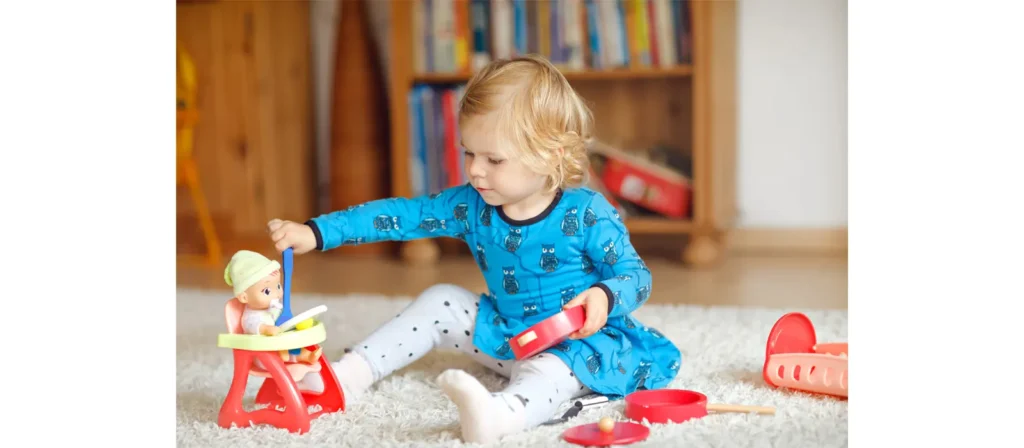
1.認知機能の発達
- 問題解決スキル:子どもたちが劇遊びをするとき、創造的な解決策を必要とする問題にしばしば遭遇する。例えば、レストランを経営するふりをするのであれば、どうやってお客を席に座らせ、注文を取り、料理を運ぶかを考える必要がある。そうすることで、子どもたちは批判的に考え、問題を解決する能力を高めることができる。
- 記憶と想起:ごっこ遊びは、記憶力を強化するための優れたツールである。子どもたちは身近なシナリオを演じながら、劇の衣装や小道具を使って物語や実体験を疑似体験し、短期記憶と長期記憶を強化する。
- 抽象的思考児童発達センターにおける劇遊びは、象徴的な思考を育みます。シンプルな棒が剣になったり、箱が宇宙船に、毛布がケープに変化したりします。こうした抽象化は、子どもたちの想像力と創造性を育むのに役立ちます。
2.社会性と情緒の発達
- 共感と視点:ロールプレイを通して、子どもたちは他人の立場になる。たとえば、子どもたちが劇遊びの中で親や先生を演じると、子どもたちはさまざまな感情や行動を理解するようになる。さまざまな社会的状況において、他人がどのように感じ、どのように対応するかを想像することで、共感を学ぶ。
- 感情調節:劇的な遊びのアイデアには、怖がったり、悲しんだり、興奮したりするふりをするなど、感情を演じることがよく含まれる。これは、子どもたちに健全な感情表現の場を提供し、実生活で自分の感情をコントロールする方法を理解するのに役立つ。
- ソーシャル・スキル:子どもたちは、集団で劇遊びをすることで、コミュニケーション、協力、交渉、紛争解決の練習をする。これらのスキルは、友情を築き、社会的な状況をうまく切り抜けるために極めて重要である。
3.言語発達
- 語彙の拡大:劇遊びを通して、子どもたちは新しい単語やフレーズ、特に "customer"、"order"、"menu"、"emergency "など、特定の役割や設定に関連した単語やフレーズを学ぶ。新しい語彙を頻繁に使うことで、言語スキルが定着する。
- ストーリーテリングと語りのスキル:ごっこ遊びは、子どもたちが起承転結のあるストーリーの組み立て方を理解するのに役立つ。新しいシナリオや物語を構成する創造性を育み、ストーリーテリングのスキルを向上させる。
- コミュニケーション劇遊びは言葉による表現を促します。子どもたちはロールプレイ中に自分の考えやアイデア、計画を仲間と伝える必要があるからです。これは、自分の考えを明確に表現し、有意義な会話に参加する能力を高めます。
4.運動発達
- 粗大運動技能:非活動的な劇遊びでは、子どもたちは走ったり、跳んだり、登ったり、踊ったりして、大きな筋肉群を発達させる。
- ファイン・モーター・スキル:小さな物のような劇遊びのおもちゃを扱ったり、劇遊びの衣装を着たり、小道具を並べたりすることは、細かい運動能力を磨くのに役立つ。これらの活動は、手先の器用さや手と目の協調性も向上させる。
家庭や幼稚園で劇遊びを奨励する方法
家庭や教室で劇遊びをするには、想像力と役割分担を促す環境作りが不可欠です。以下にいくつかの戦略をご紹介します。

プレイスペースの設定
指定エリアを作る 子どもたちが劇遊びをする場所。コスチュームや小道具、キッチン用品や道具、人形など、テーマに沿ったアイテムが置かれた居心地のよいコーナーがあれば、創造力がかき立てられる。例えば、小さなテーブルと椅子、ふりかけ、メニューがあるスペースは、子どもたちが経営するレストランに変身する。
オープンエンドの資料を提供する
子どもたちが劇遊びを楽しむのに高価なおもちゃは必要ありません。段ボール箱、古着、布、台所用品、壊れにくい家庭用品など、自由に使える素材を用意しましょう。これらの素材は、子どもたちが創造力を発揮して自分だけのシナリオを作り上げることを促します。
オープンエンドのプロップの例:
| 日用品 | ドラマチックな用途 |
|---|---|
| スカーフ | コスチューム、ケープ、ピクニックブランケット、王室のアクセサリー |
| 段ボール箱 | 宇宙船、キッチン、城 |
| 木製スプーン | マイク、魔法の杖、ドラムスティック |
| 古い携帯電話 | ビジネスプレイ、医院、面接 |
監督ではなく、励ます人になる
劇的な遊びを促すことは大切ですが、遊びを支配したり、指示したりするのは避けましょう。子どもたちは大人があまり介入することなく、自由に想像力を働かせるべきです。必要であれば、「お医者さんは次にどうすると思いますか?」「この問題を一緒にどう解決できると思いますか?」など、自由回答形式の質問をして、子どもたちが創造的に考えるように優しく導きましょう。
シンプルなテーマとシナリオを紹介する
子どもたちが始めるのに少し助けが必要な場合は、次のようなシンプルでわかりやすいテーマを紹介します。
- 医者に行く
- 食料品の買い物
- パン屋を経営する
- 宇宙探査
- 動物園を訪れる
これらのテーマは親しみやすく、ロールプレイが簡単で、言語の発達と問題解決の機会が満載です。
模範劇
大人はまた、劇遊びのアイデアを手本にして、それがどのように機能するかを子どもたちに示すこともできる。登場人物になりきったり、子どもたちと一緒にロールプレイをしたりすることで、大人は遊びの中に新しいアイデアを取り入れる方法を示すことができる。
集団プレーの機会を提供する
劇遊びは個人的な活動であることもあるが、子どもたちが協力し合うことで、より豊かなものになる。子どもたちが協力し、役割を分担できるような遊びやクラスでの活動を企画し、集団遊びを奨励する。そうすることで、社会的相互作用とコミュニケーション能力が育まれる。
小道具をローテーションして新鮮さを保つ
興奮と好奇心を維持するために、おもちゃや小道具を定期的にローテーションさせましょう。消防士の帽子がしばらく消えて、また戻ってくると、突然新鮮に感じられます。この方法は、退屈を防ぎ、ほとんど手間をかけずに遊びに活気を与えるのに役立ちます。
成果ではなくプロセスを称賛する
工作やパズルとは異なり、劇遊びは結果ではなく体験が重要です。ごっこ遊びに正解も不正解もありません。ですから、パフォーマンスや完成度にこだわるのではなく、創造性、協力、そして想像力豊かな遊びの純粋な喜びを称えましょう。
26の創造的な劇遊びのアイデア
ドラマティック・プレイは、子どもたちがさまざまな役になりきり、創造性を探求し、実社会で役立つスキルを練習することを可能にします。想像力を刺激する劇遊びのアイデアをいくつかご紹介しましょう!
1. ごっこ遊びキッチンの劇的な遊びのアイデア
- 小さなテーブルをキッチンカウンターとして、段ボール箱をコンロや冷蔵庫として、プラスチックのお皿や食器を使ってごっこ遊びをしましょう。
- ごっこ遊びやお菓子作りに、空の容器、計量カップ、おもちゃのベーキング用具を用意します。
- ロールプレイング用にエプロンとシェフの帽子を追加し、ごっこ遊びのメニューを作成し、「シンク」や「冷蔵庫」などのさまざまな場所にラベルを付けます。
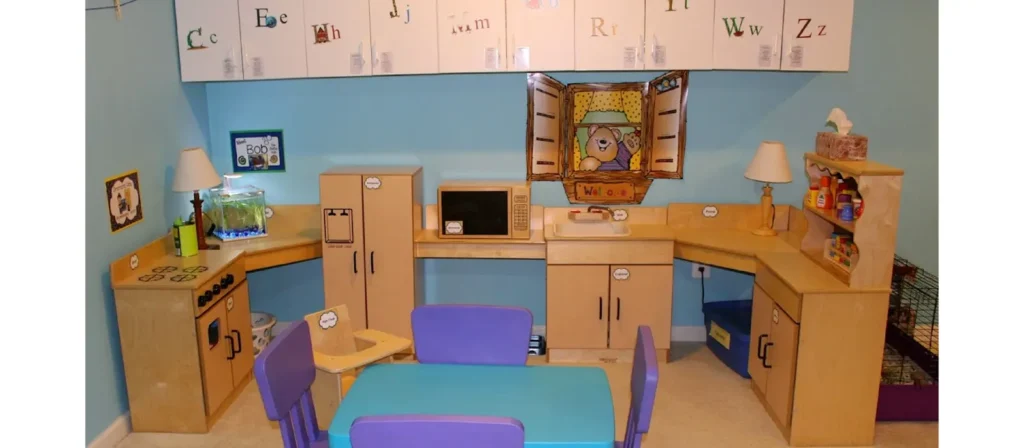
教育的価値:
ごっこ遊びは、子どもたちが想像上の料理を計画し、準備する中で、認知的順序づけと象徴的思考を育みます。料理に関する語彙の使用や会話形式のロールプレイを促すことで、言語発達を促します。調理器具、容器、道具を使うことで、細かい運動能力が強化されます。さらに、協力的な場面で、社会的な協力、責任感、順番を守る能力も育みます。
2. 花屋の劇遊びのアイデア
- カラフルな造花、ティッシュペーパーの花、あるいは本物の植物を使って、花瓶やバスケットに飾りましょう。
- 花に値段を書いて、「花屋」と書かれた看板を作りましょう。子どもたちは読み書きの練習をしたり、お金について学んだりすることができます。
- おもちゃの園芸用具を用意して、子供たちが花束を「アレンジ」したり、顧客のためにギフトラッピングしたりできるようにします。

教育的価値:
このアクティビティは、花のアレンジメント、ラベル付け、そして「販売」を通して、創造性、パターン認識、そして基本的な計算力を育みます。子どもたちは色、花、そして感情に関する語彙を広げ、同時にお客様役のロールプレイを通して社会的な交流を深めます。価格設定や取引のやり取りといったビジネスの概念を早期に導入し、花束作りやギフトラッピングといった実践的な作業を通して、細かい運動能力を磨きます。
3. 宇宙劇遊びのアイデア
- 段ボール箱や毛布を使って、ごっこ遊びのロケットを作りましょう。子どもたちは交代で宇宙飛行士、管制官、宇宙探査機などを演じることができます。この遊びは、想像力、問題解決能力、そして社会的な交流を育みます。
- ヘルメット、望遠鏡、宇宙地図などの「宇宙ギア」を子どもたちに提供しましょう。子どもたちは新しい惑星を探検し、異星人と出会い、新しい世界を発見するミッションに挑戦しながら、チームワークと探検について学ぶことができます。
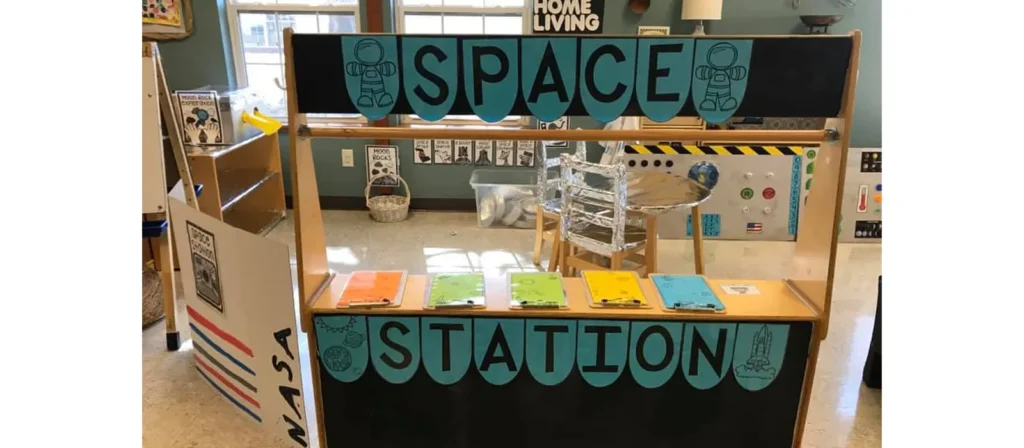
教育的価値:
宇宙をテーマにした劇遊びは、子どもたちが惑星や星、そしてミッションを探求する中で、抽象的思考、空間推論、そして初期の科学的探究心を育みます。天文学や宇宙探査に関する語彙を習得するとともに、宇宙飛行士、エンジニア、エイリアンといったチームでの役割分担を通して、協調性を強化します。こうした想像力豊かな遊びは、好奇心、物語の展開、そして認知の柔軟性を育みます。
4. 食料品店の劇遊びのアイデア
- 顧客とレジ係の役割:一人の子どもがお客さん役になって買い物をし、もう一人の子どもがレジ係になって商品を精算し、お金を扱う。これは、子どもたちがコミュニケーションや算数、社会性を練習するのに役立つ。
- 買い物リスト子どもたちに、買うべき品物の写真や名前が書かれた買い物リストを渡しましょう。こうすることで、子どもたちは読み書きや仕分けの練習をしながら、品物を特定し、見つける練習をすることができます。
- 棚のストック:子供たちは店員として交代で棚に商品を並べることができる。これは整理整頓と責任感を教える。
- 袋詰めとチェックアウト:買い物」の後、子どもたちは食料品の袋詰めやレジの使い方を練習し、運動能力を発達させ、取引のプロセスを理解する。
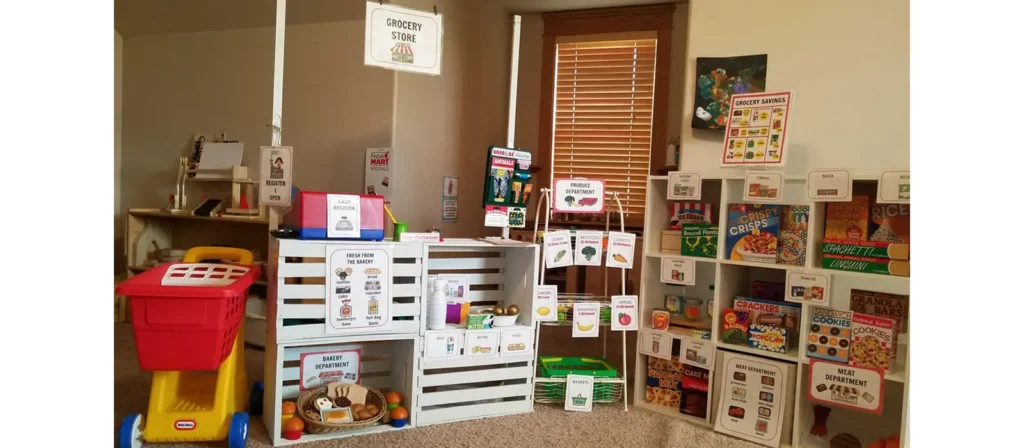
教育的価値:
おもちゃのスーパーマーケットは、子どもたちが食品を数えたり、仕分けたり、分類したりする練習をする有意義な機会を提供し、早期の算数能力と認知的組織化能力を強化します。買い物リスト、値札、店の看板を読むことで、機能的読み書き能力が養われます。また、子どもたちは、リアルな接客とレジ係とのやり取りを通して、忍耐力、協力力、問題解決能力といった社会情動的能力を育みます。
5. 郵便局の劇遊びのアイデア
- 郵便局のカウンターとして小さなテーブルを用意します。箱やかごを郵便受けに見立て、カウンターの後ろに椅子を置いて「郵便局員」を演じます。
- 封筒、ハガキ、小包などを用意しましょう。紙や厚紙で「手紙」を作り、それぞれに宛名を書いてラベルを貼るのも良いでしょう。
- ステッカーや切手を使って郵便料金を表現しましょう。子どもたちは手紙や荷物に「切手」を貼ることで、細かい運動能力を鍛えることができます。
- おままごと用のレジ、郵便配達員のバッグ、郵便仕分け用の箱などのアクセサリーも用意しましょう。おもちゃの電話を使って電話に出たり、配達をしたりすることもできます。

教育的価値:
郵便局ごっこは、子どもたちが郵便物を作成し配達する中で、書き言葉の理解、活字体の認識、そして有意義な読み書きの経験を促します。切手を貼ったり、仕分けたり、封筒を扱ったりすることで細かい運動能力を発達させるとともに、宛名書き、ラベル貼り、メッセージを送ることで言語能力の発達を促します。また、この遊びを通して郵便局員の役割を紹介し、地域の支援者やコミュニケーションシステムへの意識を育みます。
6. スーパーヒーロー劇遊びのアイデア
- 子どもたちが大好きなスーパーヒーローに扮装できるよう、ケープ、マスク、シールドを用意しましょう。障害物コース、敏捷性テスト、世界を救うミッションなど、トレーニング課題を用意するのも良いでしょう。これらのアクティビティは、身体活動、問題解決能力、そしてチームワークを育みます。
- 「ミッションコントロール」ステーションを設置し、子どもたちがトランシーバー、地図、ミッションログを使ってスーパーヒーローミッションを計画し、進捗状況を追跡できるようにします。これにより、チームワーク、コミュニケーション、そして創造的なストーリーテリングが促進されます。

教育的価値:
スーパーヒーローごっこ遊びは、子どもたちが公平さ、勇気、そして他者を助けることといった概念を探求する中で、道徳的な発達を促します。ミッションに基づいた物語を通して、表現力豊かな言語能力と物語的思考力を育みます。活発な動きを通して粗大運動能力が強化され、協力的な「救助」のシナリオを通してチームワークとリーダーシップが育まれます。
7. 建設現場の劇遊びのアイデア
- 子どもたちが家や道路、その他の構造物を「作る」ことができる建設ゾーンを設定します。 ブロック おもちゃの建設工具などを使って、子どもたちは建設作業員、建築家、エンジニアになりきって、形や寸法、工学の概念を学ぶことができます。
- 子どもたちに建設用帽子、工具ベルト、安全ゴーグルを用意しましょう。こうすることで、子どもたちは建設作業員や安全検査員の役割を担い、安全と責任感を育むことができます。

教育的価値:
建築をテーマにした遊びは、子どもたちが構造物を作ったり設計したりすることで、基本的な工学原理と空間認識力を養います。道具や材料を使うことで、粗大運動と微細運動の協調性を育みながら、問題解決能力と計画能力を強化します。また、共同作業を通して、社会的な交流、順番を守ること、そして協力の精神も育まれます。
8. 庭での劇遊びのアイデア
- 造花、鉢、そして茶色の布か紙で作った土を小さなスペースに用意しましょう。植物の種類ごとに「花」や「野菜」など、ラベルを貼っておきましょう。子どもたちは庭師ごっこをして、花を植えたり、植物に水をあげたり、庭の手入れをしたりすることができます。庭を「育てる」ことで、様々な植物について学ぶこともできます。
- 子供サイズの園芸用具、じょうろ、手袋を用意しましょう。植物を「収穫」するための小さなバスケットやバッグも使えます。
- スペースに余裕があれば、子供たちが偽のお金と値札を使って植物や花を売るふりをできる小さな「市場」を作りましょう。
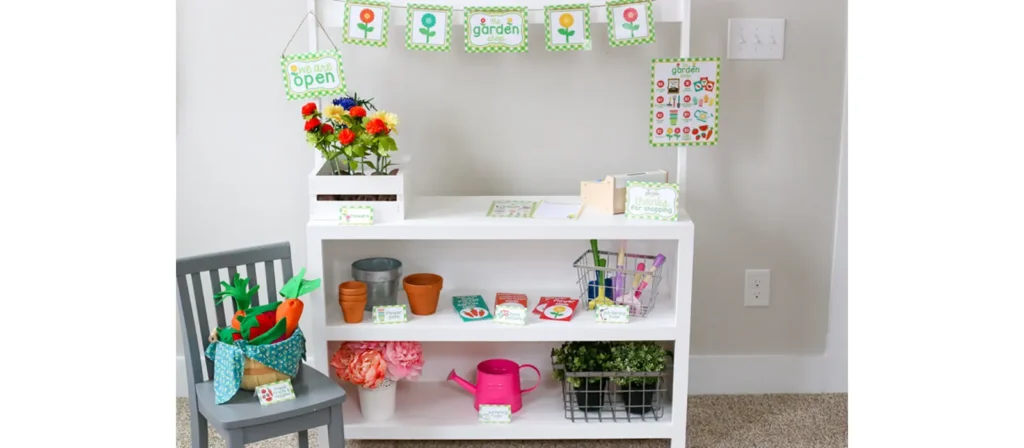
教育的価値:
園芸活動は、植え付け、水やり、収穫に焦点を当てたロールプレイを通して、責任感、忍耐力、そして自然への感謝の気持ちを育みます。子どもたちは、掘ったり、水を注いだり、道具を使ったりすることで、細かい運動能力を身につけながら、植物のライフサイクルと環境保護への理解を深めます。また、分類、感覚探索、そして初期の科学概念の理解を促します。
9. 病院や診療所での劇遊びのアイデア
- おもちゃの聴診器、包帯、白衣などを用意して、子どもたちがお医者さんや看護師ごっこをできるようにしましょう。病気の人形やぬいぐるみのお世話をしたり、医療処置について学んだり、患者や介護者の役割を演じたりすることもできます。
- 「病院の救急室」のシナリオを作り、子どもたちが医師、看護師、患者の役を演じます。これは、共感力、責任感、そして医療に関する基本的な理解を育みます。
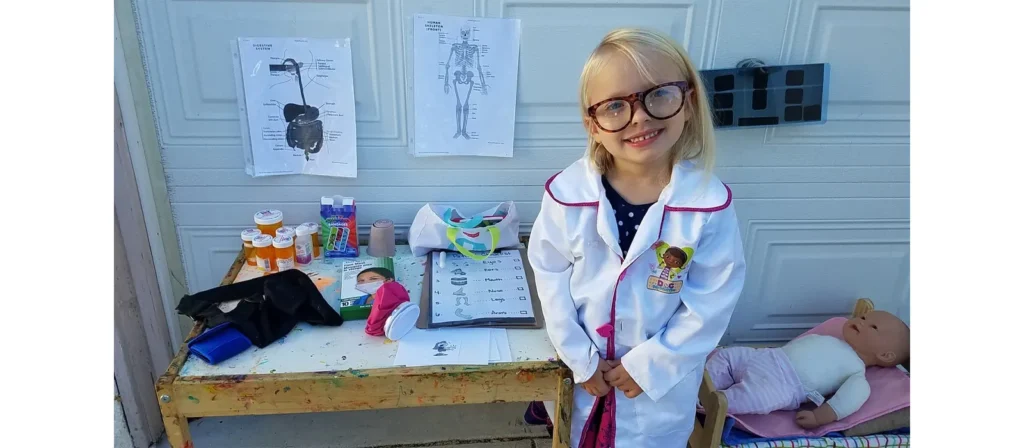
教育的価値:
お医者さんごっこを通して、子どもたちは患者さんのお世話をしたり、人体について学んだりすることで、健康、衛生、そして共感について深く学ぶことができます。医学用語が紹介され、強化されるとともに、診断や治療に関する会話を通して、表現力豊かな言語を練習します。包帯を巻いたり、器具を使ったりといった細かい動作を通して、微細運動能力が発達し、子どもたちは地域社会における保健の役割に対する意識を高めます。
10. 農場 劇的な遊びのアイデア
- おもちゃの動物(または本物のぬいぐるみ)と、じょうろや熊手などの農具を使って、農場の雰囲気を再現しましょう。子どもたちは農家の人になりきって、動物の世話をしたり、作物を植えたり、農場を管理したりすることができます。
- 子どもたちは、ごっこ遊びの農園の屋台を設営して、果物、野菜、卵などの商品を「売る」ことができます。これは、農業、経済、そして責任感について学ぶ機会となります。

教育的価値:
農場遊びは、子どもたちに農業のプロセス、動物の世話、そして「農場から食卓へ」というコンセプトを紹介し、科学と環境学習をサポートします。子どもたちは、忍耐力、責任感、育児行動といった社会情動的スキルを身につけます。また、豊富なロールプレイを通して、農具、動物、農産物に関する語彙を増やしていきます。
11. レストランとカフェの劇遊びのアイデア
- 注文を受けるための食器、メニュー、メモ帳を置いたテーブルを用意します。
- ウェイターやシェフにエプロンと帽子を提供し、近くに模造のキッチンを作りましょう。
- 「営業中」や「閉店」などの看板を掲げ、取引用のお金を模造します。
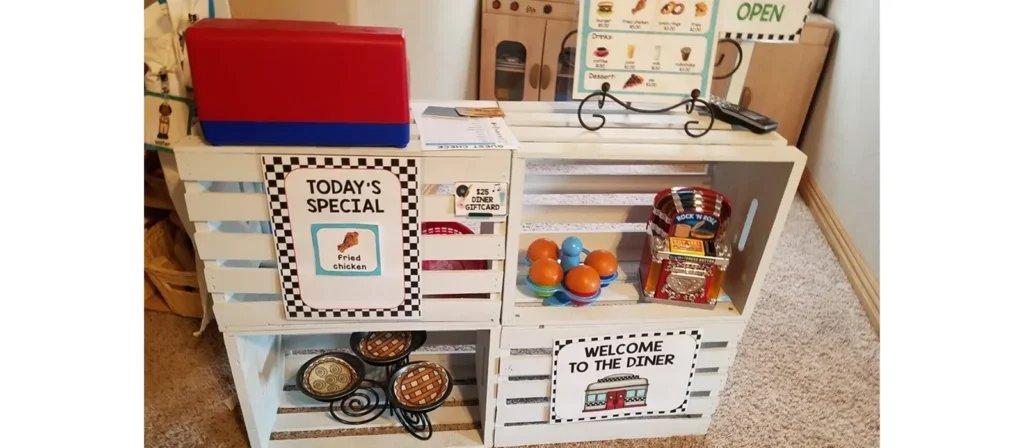
教育的価値:
おままごとレストランを運営することで、子どもたちは注文を受け、料理を運び、「支払い」をすることで、順序立てて考える力、記憶力、そしてコミュニケーション能力を育みます。メニューの値段を知ることで算数の能力が鍛えられ、礼儀正しい社会的な交流も促されます。料理の配膳や準備を通して運動能力が鍛えられ、役割や責任を共有することで協調性が育まれます。
12. 動物病院の劇遊びのアイデア
- ぬいぐるみを、ケアを必要とする「患者」としてテーブルや毛布の上に並べます。
- 検査や治療のために、おもちゃの注射器、体温計、ペットキャリアなどを用意してください。
- 「チェックイン」、「手術」、「回復室」などのラベルを各ステーションに付けます。
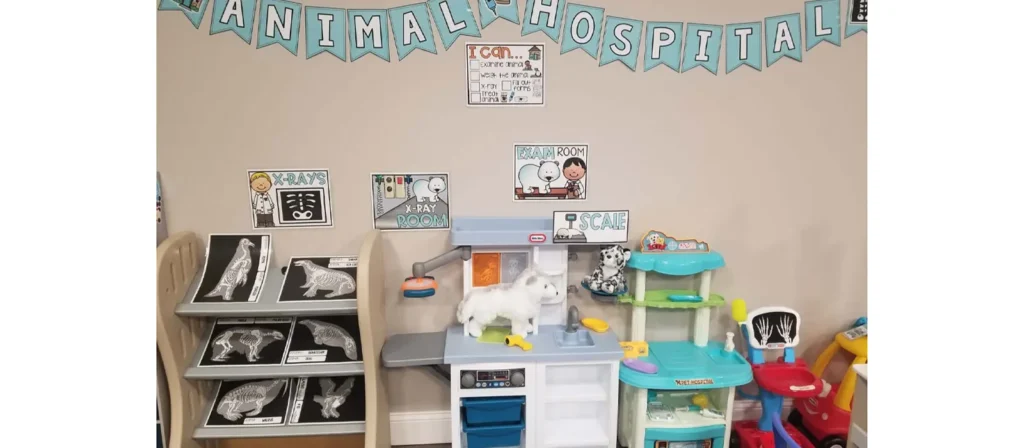
教育的価値:
この劇的な設定は、子どもたちが病気や怪我をした動物を見極め、世話をすることで、共感力、観察力、そして批判的思考力を養います。獣医学の用語や健康の概念は年齢に応じた方法で紹介され、細かい運動能力は 医療器具の使用と優しい取り扱い。役割のアイデンティティとケアに基づく推論を促します。
13. 消防署の劇遊びのアイデア
- 赤い紙製の帽子、消防車に見立てた段ボール箱、トランシーバーなどを使って、ドラマチックな消防署のセットアップを作りましょう。
- 子どもたちに、緊急電話を受けて現場に急行し、想像上の火事からぬいぐるみを救出するふりをさせましょう。
- 子どもたちはロールプレイを通して、チームワーク、素早い意思決定、安全意識といった生活に欠かせないスキルを練習します。
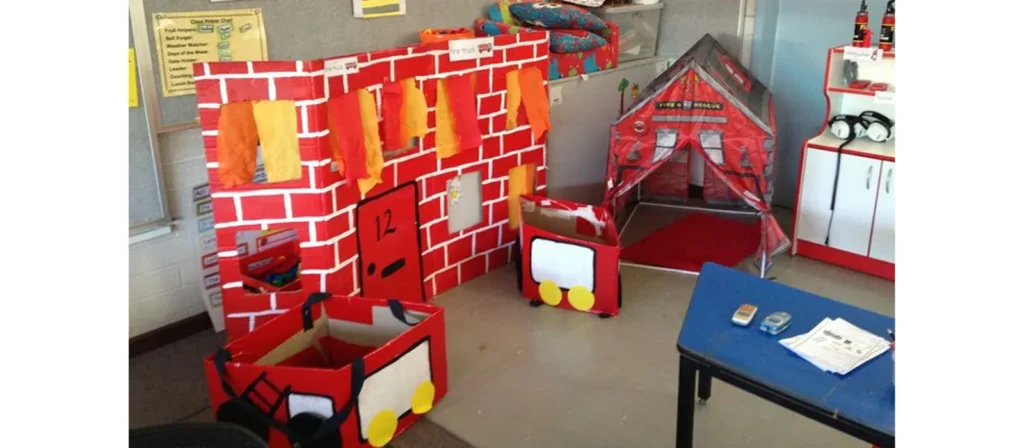
教育的価値:
消防士のロールプレイでは、緊急時の対応シナリオを通して、安全教育、素早い思考、そして身体的な協調性を重視します。公民としての義務を理解し、救助機材や手順に関する語彙を学びます。子どもたちは、勇敢な救助や警報を交代で演じることで、リーダーシップ、協力、そして問題解決能力を養います。
14. キャンプ劇遊びのアイデア
- テントや毛布の砦、懐中電灯、ティッシュペーパーやペーパータオルのロールで作った模造キャンプファイヤーを用意します。
- 子どもたちに、おもちゃのリュックを詰めさせたり、火を囲んで物語を話させたり、串に刺したマシュマロを「焼いて」みたりさせましょう。
- キャンプ遊びは、物語を語る力、自立心、自然への感謝の気持ちを育みます。

教育的価値:
キャンプのシナリオは、テント設営、調理、自然探検といった体験を通して、子どもたちの自立心と自己統制力を育みます。物語を語る力、順序立てる力、想像力豊かな思考力を育むとともに、グループでの協力や話し合いの機会も提供します。子どもたちはまた、幼い頃から屋外での安全と環境への感謝の気持ちを育みます。
15. 宝探し劇遊びのアイデア
- 古びた紙やプリントアウトを使って宝の地図をデザインしましょう。小さな宝物(おもちゃのコイン、宝石、小物など)を部屋や遊び場に隠しましょう。
- 一連のなぞなぞ、絵のヒント、方向を示す矢印を使って子供たちを導き、段階的に隠された賞品へと導きます。
- このアクティビティは、批判的思考、順序付け、チームワークを強化し、子供たちが指示に従い、好奇心を持ち続けるように促します。
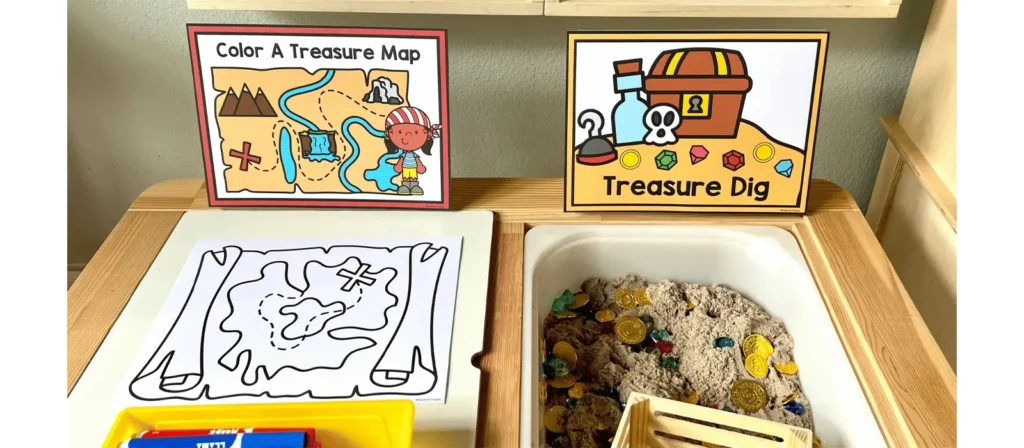
教育的価値:
宝探しは、論理的思考力、空間ナビゲーション、手がかりの解釈を促し、問題解決能力と批判的思考力の基礎を育みます。子どもたちが共通の目標に向かって取り組む中で、チーム内での連携とコミュニケーションが強化されます。このアクティビティは、目標達成に向けた探求における粘り強さと意欲を育みます。
16. 海賊船の劇遊びのアイデア
- 子どもたちは、活気のある環境でのロールプレイや冒険を通して、コミュニケーション能力、リーダーシップ、協力的なストーリーテリングを身につけます。
- 段ボール箱、椅子、毛布などで海賊船の模型を作りましょう。紙の帆、段ボールの舵輪、海賊帽も加えましょう。
- 子どもたちに船長、見張り、航海士などの役割を担わせましょう。おもちゃの望遠鏡、地図、旗を使って、想像上の国を目指して航海に出かけましょう。
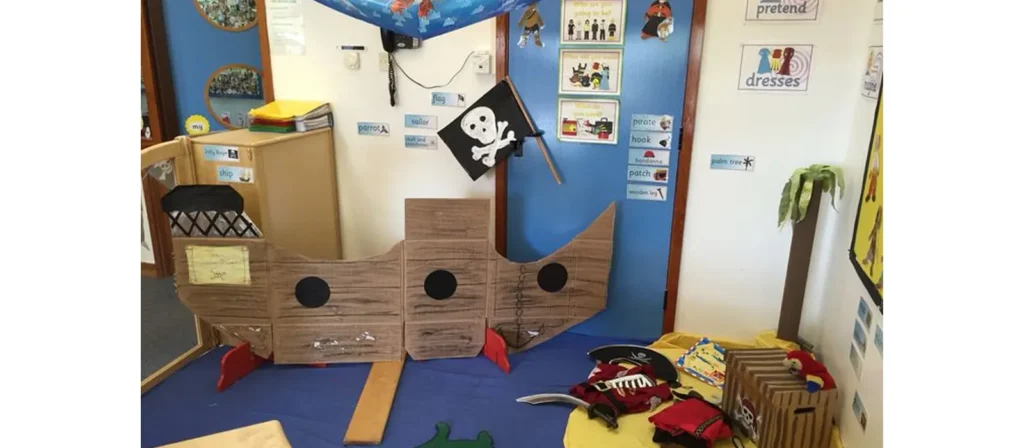
教育的価値:
海賊ごっこは、子どもたちが冒険や航海のロールプレイを通して、創造的な物語の語り方、リーダーシップ、そして協調性を育みます。方向感覚、地図の読み方、象徴的な思考を育むだけでなく、会話や空想を通して豊かな言語表現を育みます。グループダイナミクスや問題解決能力は、ミッションを共有する遊びの中に自然と組み込まれています。
17. 図書館での劇遊びのアイデア
- 棚に本を積み上げ、快適な椅子や読書用マット、チェックアウトデスク、図書カードなどを追加します。
- 子どもたちは交代で司書となり、サークルタイムに本の整理、貸し出し、そして物語の読み聞かせを行います。他の子どもたちは、本を閲覧したり「借りる」ことで静かに読書をすることができます。
- 子どもたちは、読む力を高め、アルファベットの知識を練習し、組織、ルール、地域社会における図書館の役割について学びます。

教育的価値:
図書館遊びは、子どもたちが本を借り、整理し、読む中で、早期の読み書き能力、本の扱い方、そして物語の順序づけを育みます。図書館のシステムや役割への理解を促し、語彙力と活字への理解を深めます。また、子どもたちはグループ読書の場でルールを守り、順番を守ることで、忍耐力と責任感を育みます。
18. 恐竜発掘劇遊びのアイデア
- 感覚ビンや砂場にプラスチックの骨や化石を隠して詰めましょう。絵筆、シャベル、虫眼鏡も用意しましょう。「古生物学者歓迎!」などの看板で周囲を飾りましょう。
- 子どもたちは探検家のベストとヘルメットを着用し、化石を発掘し、フィールドジャーナルや展示テーブルに発見したことを記録します。
- 子どもたちは、現実世界の古生物学者を真似しながら、基本的な科学用語を学び、観察スキルを磨き、発見のスリルを体験します。
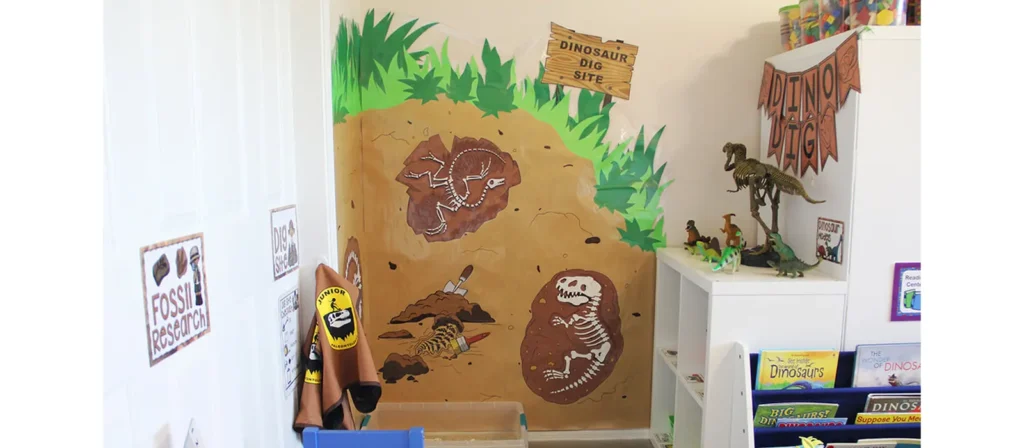
教育的価値:
恐竜をテーマにした発掘体験を通して、子どもたちは古生物学、科学的な分類、そして綿密な観察を学ぶことができます。発掘道具を使うことで細かい運動能力の発達を促し、化石発見時の細部への注意力を高めます。子どもたちは発見した事実を記録し報告する練習をすることで、語彙力の拡大と体系的な探究心を育みます。
19. 動物園の飼育員の劇遊びのアイデア
- ぬいぐるみを、ラベルを貼った様々な「生息地」に配置しましょう。餌やり道具や飼育員の制服などの小道具も用意しましょう。
- 子どもたちは動物園の飼育係として、動物に餌をあげたり、囲いを掃除したり、ガイドツアーをしたりします。
- この劇は、動物の世話、生息地、保護の重要性について学ぶことを促します。
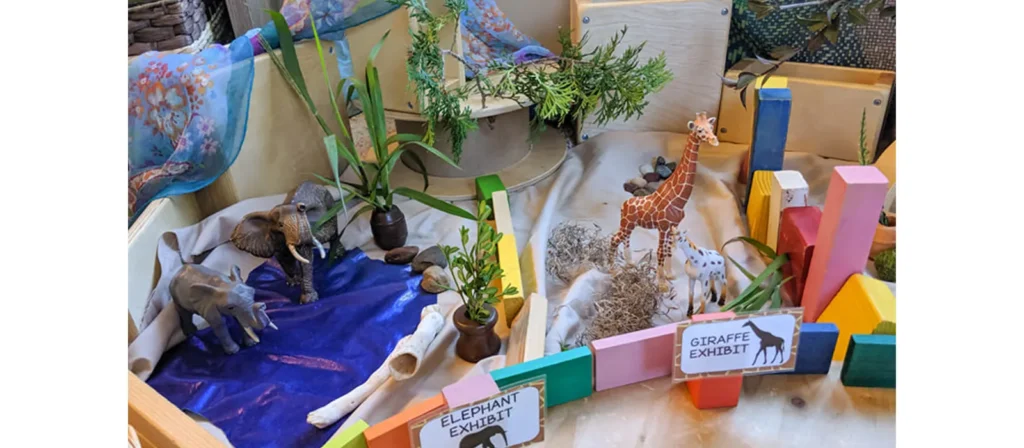
教育的価値:
動物園の飼育員ごっこは、体系的な飼育シナリオを通して、動物、生息地、そして自然保護への理解を深めます。子どもたちは、餌やり、掃除、そして生息地の創造といった活動を通して、生物学に関する語彙力と責任感を育みます。また、仲間たちによるガイド付き「ツアー」を通して、共感力と人前で話す力を育みます。
20. 天気予報ステーションを使った劇遊びのアイデア
- 地図、天気記号、温度計、マイクなどを含めます。
- 子どもたちは気象学者になりきって天気を予測し、予報を発表することができます。
- この劇は、人前で話す能力を向上させ、天気のパターンと気候について教えてくれます。
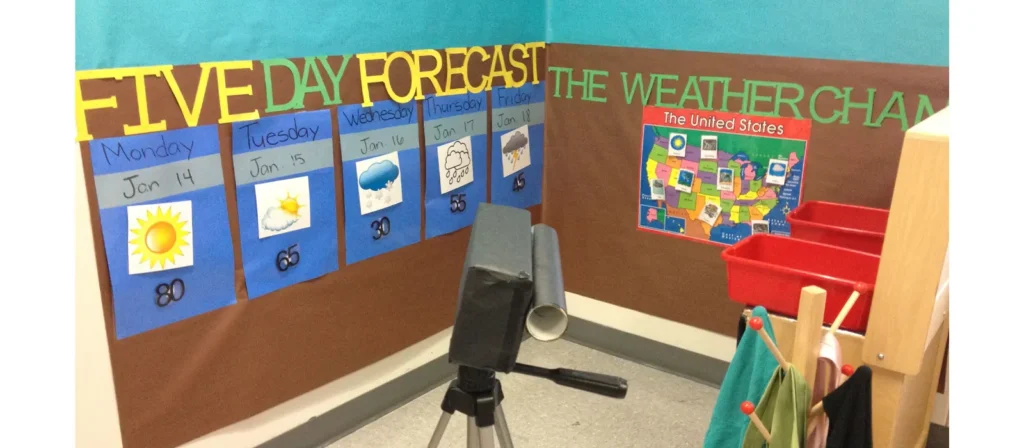
教育的価値:
気象観測所の操作は、科学的な観察、データの解釈、そして環境への意識を育みます。子どもたちはパターンを認識し、予測することを学び、早期の探究心と分析力を育みます。天気予報や地図、記号、道具を使った象徴的な表現を通して、言語発達も促進されます。
21. ニュース局が劇的な演劇のアイデアを放送
- このアクティビティは、楽しく体系的な方法で自信、語彙力、人前で話す力を養います。
- テーブルをニュースデスクとして配置し、マイク、カメラ(本物または偽物)、紙の台本を追加します。
- 子どもたちは、天気予報やニュース速報、インタビューなどを報道するアンカー、レポーター、カメラマンなどの役を演じることができます。
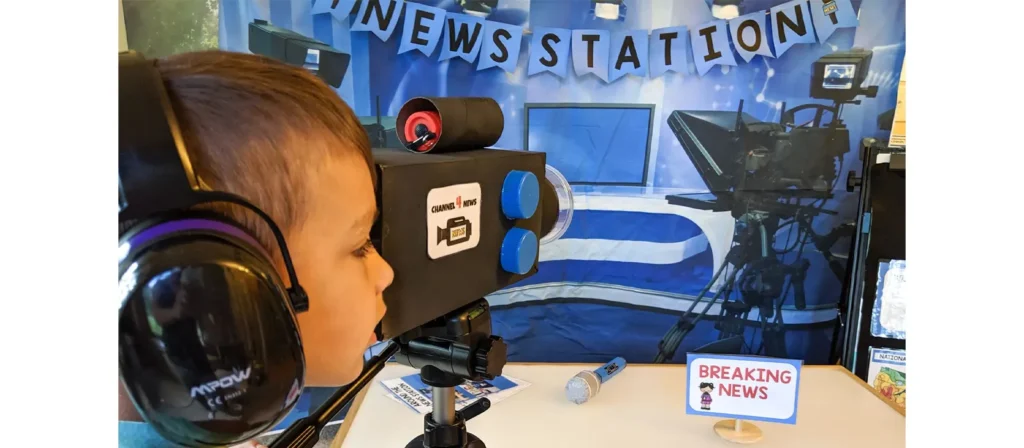
教育的価値:
ニュースレポーターやキャスター役を演じることで、表現力、物語の展開、そして人前で話す自信が養われます。子どもたちは、情報を整理し、出来事を要約し、メッセージを伝える練習をします。このロールプレイはチームワークを育み、時事問題や地域の出来事への意識を高めるのに役立ちます。
22. 映画館の劇的な遊びのアイデア
- 椅子を並べたり、映画のチケットを印刷したり、おもちゃのポップコーンやスナックを用意したりします。
- 子どもたちに案内係、チケット収集係、あるいは「映画」を演じたいという場合は演者の役割を割り当てます。
- これは、子供たちが順序付け、顧客とのやり取り、パフォーマンス アートを理解するのに役立ちます。
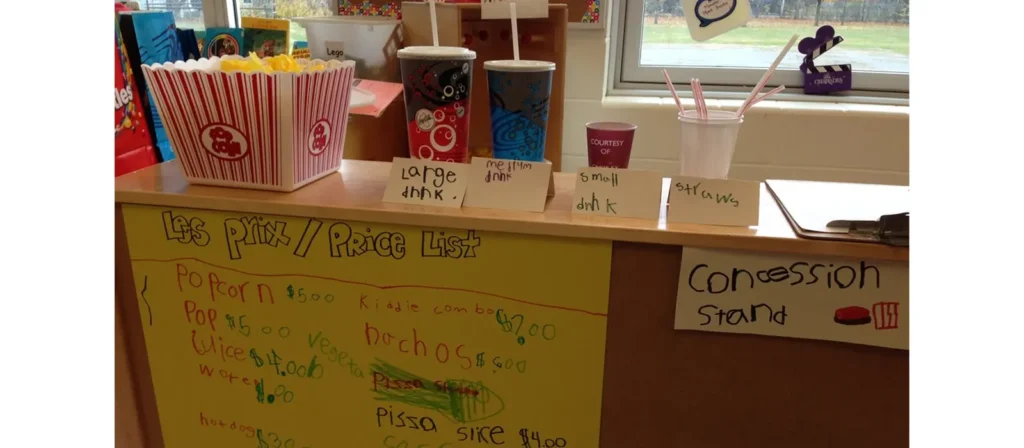
教育的価値:
映画館ごっこは、演技、チケット販売、案内係の役割を通して、観客とのやり取り、そして劇的な表現力を養います。子どもたちは観客の一員として忍耐力とエチケットを身につけると同時に、パフォーマンスやストーリーテリングにおける創造力を育みます。また、値段の決め方や役割に応じた責任を通して、算数の概念も強化されます。
23. 王家の王国劇遊びのアイデア
- 段ボールのお城を作り、安全な素材で作られた王冠、ローブ、魔法の杖や剣を追加します。
- 子どもたちは、物語に沿った冒険や王室の責任を担う王、女王、騎士、またはドラゴンの役割を演じます。
- 子どもたちは、気まぐれな設定の中で、社会の力学、意思決定、物語の語り方を学びます。
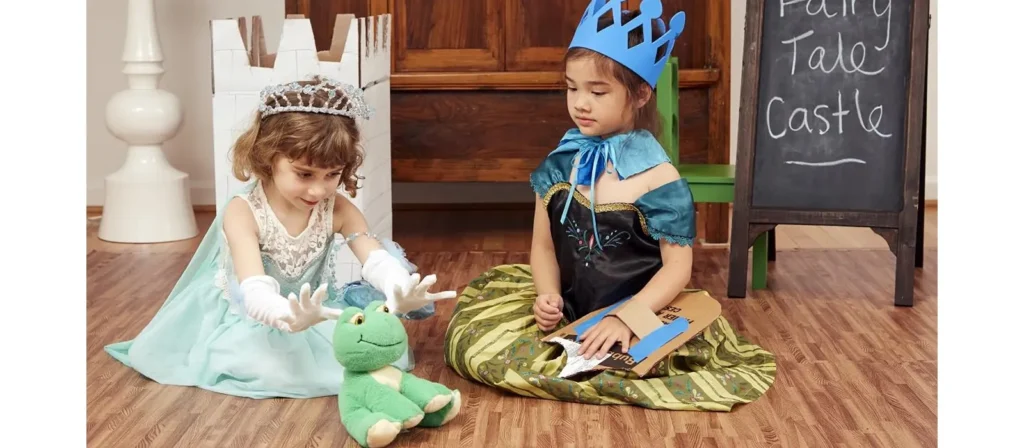
教育的価値:
遊ぶ 王室は、子どもたちが社会的な役割、意思決定、そして象徴的なルールの創造を探求する機会を提供します。豊かな物語表現、キャラクターの発達、そして歴史的想像力を育みます。子どもたちが役割を交渉し、対立を解決し、想像力豊かな社会をリードする中で、社会情動的学習が根付いていきます。
24. 空港での劇遊びのアイデア
- 飛行機の客室を模して椅子を並べ、パスポートやチケットを置くチェックインカウンターを設置し、「手荷物受取所」や「保安検査場」などのゾーンを割り当てます。
- 子どもたちは、アナウンスをするパイロット、スナックを配る客室乗務員、スーツケースを持って搭乗し、さまざまな目的地へ向かう模擬飛行をする乗客などのロールプレイを楽しむことができます。
- この劇では、待つこと、順番を守ること、手順に従うことを練習しながら、空港の手続き、地理、世界の文化を子どもたちに紹介します。

教育的価値:
空港ごっこは、子どもたちに旅行の手順、順番、文化地理を教えます。パイロット、アテンダント、乗客の役割を演じることで、役割分担を促します。このアクティビティは、忍耐力、指示に従う力、協力する力を育むとともに、標識、チケット、搭乗手続きを通して機能的リテラシーを強化します。
25. 科学実験室の劇遊びのアイデア
- 子供サイズの実験着、ゴーグル、スポイト、ビーカー、カラフルな液体(食品着色料が入った水など)を使用して、模造の科学実験室を作りましょう。
- 子どもたちに科学者の役割を演じさせ、「化学物質」を混ぜたり、安全な実験を行ったり、結果をノートに記録したりさせます。
- チャート、拡大鏡、観察カードを追加して、実際の科学的手順をシミュレートします。
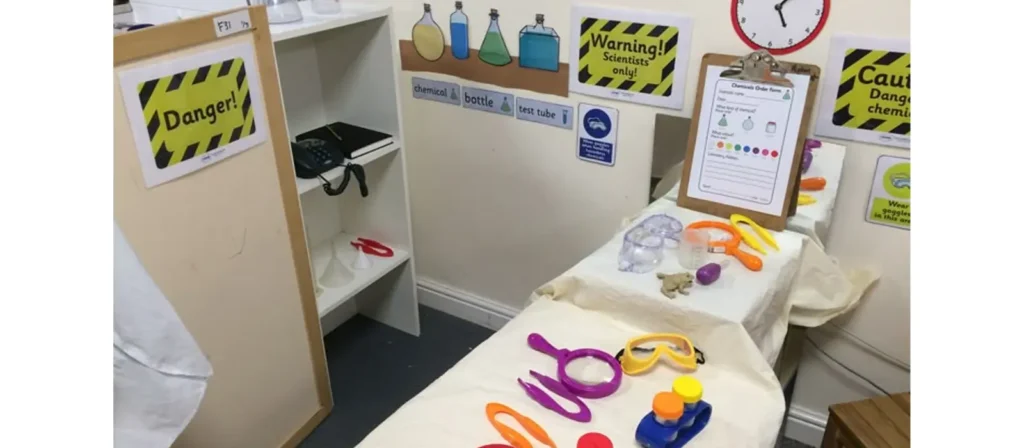
教育的価値:
科学実験室遊びは、探究心、実験、そして仮説形成を促します。子どもたちは、安全なごっこ遊びを通して因果関係を探究し、科学的な語彙と論理を育みます。道具を使ったり混ぜたりすることで細かい運動能力を磨き、年齢に応じた観察と記録の練習を促します。
26. 音楽バンドの演奏
- タンバリン、マラカス、太鼓、木琴、キーボードなど、さまざまな楽器を提供します。
- 子どもたちにバンドメンバー、歌手、指揮者などの役割を与え、一緒に演奏のリハーサルをさせます。
- 創造的な表現とグループの参加を促すために、「ステージ」、観客席、衣装などの要素を追加します。
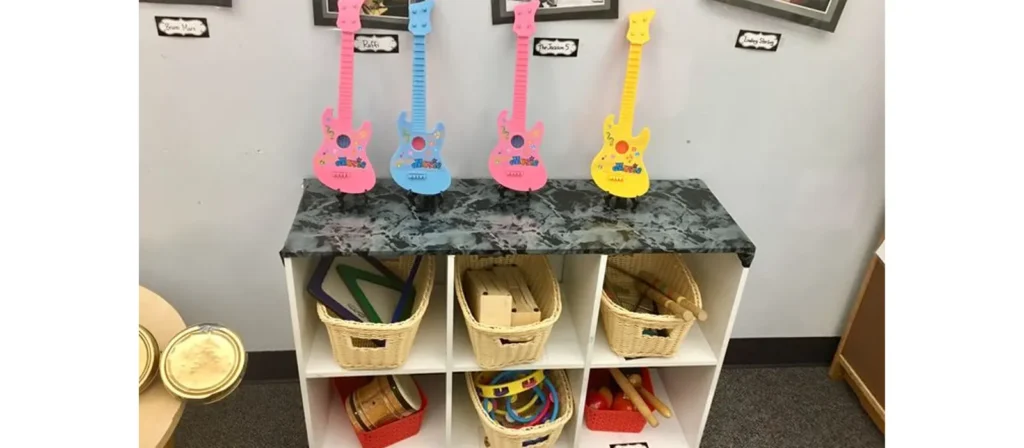
教育的価値:
音楽バンドの演奏は、リズム認識、聴覚識別、そしてタイミングを養います。子どもたちは楽器演奏を通して協調性と自己表現力を養います。グループで音楽を作ることは、協力、交代、そして創造性の共有を促すと同時に、音、テンポ、そして文化の多様性への理解を育みます。
ドラマチックな遊び場を作る
よくデザインされた劇遊び場は、あらゆる幼児期の環境において、想像力豊かな探求の拠点となります。教室、プレイルーム、あるいは家庭など、この空間は子どもたちが新しい役割を演じ、物語を語り、ロールプレイを通して周囲の世界を理解するよう促します。以下は、活気に満ちた発達を促す劇遊び場を作るための必須要素と専門家からのヒントです。
1. 明確で柔軟なスペースを選ぶ
読書やパズルなどの静かな活動とは別に、劇遊びのための特別なエリアを設けましょう。こうすることで、子どもたちは精神的に「想像力豊かなモード」に移行しやすくなります。低い棚、ラグ、カーテンなどを使って、遊びの境界線を明確にしましょう。キッチン、診療室、宇宙ステーションなど、様々なテーマに対応できる柔軟性のある空間にしましょう。
2. 自由に使える小道具と現実的な素材を用意する
段ボール箱、スカーフ、積み木など、自由に使える素材とリアルな小道具を組み合わせ、遊び場を作りましょう。高価なものである必要はありません。リサイクルボックスや寄付金集めで集めたものも数多くあります。創造性を刺激するために、様々なテーマに再利用できる素材を選びましょう。



3. 読み書きと計算の要素を含める
読み書きや数え方を学ぶ機会を劇遊びエリアに組み込むことで、学習の可能性を高めましょう。例えば、以下のようなことが挙げられます。
- メニュー、買い物リスト、予定表
- 値札、時計、おもちゃのお金
- 地図、標識、切符、ラベル
これらのアイテムは、ごっこ遊び中に子供たちが自然に学術的な概念を理解するのに役立ちます。
4. テーマと教材を定期的に入れ替える
子どもたちの興味を高く保ち、学習体験を広げるために、劇遊びのテーマを数週間ごとに変えましょう。次のテーマを決める際に子どもたちを参加させることで、子どもたちの自信と学習意欲を高めることができます。よくあるテーマのローテーションには以下のようなものがあります。
- 食料品店
- 動物病院
- キャンプアドベンチャー
- 気象ステーション
- 海賊船
5. 包括的かつ文化的に適切な遊びを支援する
多様な文化、家族の形態、地域社会での役割を反映した空間を心がけましょう。多様な衣装、肌の色の異なる人形、多言語の案内板などを用意しましょう。劇遊びは、すべての子どもが自分自身や周りの人たちを肯定的に表現する機会を提供するべきです。
6. 安全と清潔さを優先する
すべての小道具や家具は、年齢に適しており、無毒で、鋭利な角のないものにしてください。頻繁に触れる物は、定期的に摩耗や損傷がないか確認し、消毒してください。柔らかい家具や丸みのある角を使い、簡単にアクセスできる環境を整えることで、事故を防ぎ、自立を促します。
ご質問やお見積もり依頼がございましたら、メッセージをお送りください。私たちの専門家は、48時間以内に返信を与え、あなたが望む適切な製品を選択するのに役立ちます。
劇的な遊びのアイデアにおける課題の克服

1. リソースまたは材料の不足
劇遊びで最もよくある課題の一つは、活動を完全に支えるための材料が不足していることです。小道具、衣装、遊び道具など、適切な道具がなければ、子どもたちは特定のシナリオに取り組むのに苦労するかもしれません。
ソリューションすでに持っている資源を活用して、創造力を発揮しましょう。段ボール箱などの家庭用品は、ストーブ、冷蔵庫、車などに生まれ変わります。古着は衣装に、木のスプーンやプラスチック容器などの簡単なおもちゃは、料理や買い物に使えます。さらに、子どもたちに自分で材料を作るように促しましょう。例えば、紙や布を使ってメニューや値札、花などを作ることもできます。これは材料の問題を解決し、創造性と問題解決能力を育みます。
2. 注意力が短い
幼い子どもたちは、劇的な遊びのシナリオに長時間集中し続けるのに苦労することがよくあります。役割を頻繁に変えたり、活動への興味を失ってしまったりすることがあります。
ソリューション遊びの時間は短く、ダイナミックにしましょう。アクティビティを管理しやすいセグメントに分割することで、子どもたちがスムーズに役割やシナリオを切り替えられるようになります。例えば、レジ係を20分間担当させるのではなく、数分ごとに役割を変えてみましょう。こうすることで、新鮮でワクワクした体験が生まれます。また、遊びの途中で新しい要素(サプライズゲストや「特別な配達」など)を取り入れることで、子どもたちの興味を刺激し、集中力を維持することができます。
3. 子ども同士の対立
劇遊びでは、多くの場合、同じ場所や役割を共有するため、子ども同士の衝突が生じることがあります。誰がどの役割を演じるべきか、あるいはゲームをどのように展開させるべきかといった意見の相違は、遊びの流れを乱す可能性があります。
ソリューション子どもたちが協力し、役割分担をするように促しましょう。順番を守る、小道具を共有するなど、明確な基本ルールを作ることも、争いを防ぐのに役立ちます。争いが起こった時は、一緒に問題を解決する方法を聞いたり、新しい役割を提案したりするなど、子どもたちが問題解決の戦略を学べるよう導きましょう。社会情動的学習は劇遊びの核となるため、こうした機会を利用して共感、敬意、チームワークを育むことが重要です。
4. 限られた社会的交流
劇遊びは社会性を育みますが、中にはこうした活動中に友達と交流することに苦労する子どももいます。恥ずかしさや威圧感を感じたり、他の人とどう関わっていけばいいのか分からなかったりするかもしれません。

ソリューション劇遊びのシナリオを設定することで、自然とグループでの参加を促します。例えば、レジ係と客がそれぞれ1人ずつという設定ではなく、より大きな食料品店やレストランを舞台に、複数の子どもが同時に異なる役割(レジ係、客、在庫管理係、店長など)を担えるようにします。こうすることで、子どもたちはより緊張感のない環境で交流を深めることができます。さらに、会話やヒントを提示することで、遊びを段階的に進めていくことで、話すのが苦手な子どもや、主導権を握るのが苦手な子どもにも役立ちます。
5. ロールプレイの難しさ
子どもたちは、劇遊びの中で特定の役割を演じることが難しいと感じるかもしれません。お医者さん、シェフ、先生などの役割をどう演じるべきか分からなかったり、遊びの中での自分の役割に自信が持てなかったりするかもしれません。
ソリューションそれぞれの役割を説明した簡単な役割カードや台本を用意しましょう。例えば、「お医者さんの役割カード」には、「今日の気分はどうですか?」や「体温を測りましょうか?」といったフレーズを盛り込み、子どもたちがロールプレイをする際のガイドとして活用しましょう。レストランのお客さんや教室の先生になりきるなど、実際の行動を手本にしたり、実例を見せたりすることで、子どもたちが役になりきる助けになります。子どもたちが間違いを恐れることなく、安心して様々な役割に挑戦できる安全な環境を作ることが重要です。
6. 選択肢の多さに圧倒される
劇遊びでは多くの選択肢が提示されることが多く、子どもたちは時に圧倒されてしまうことがあります。どこから始めたらいいのか分からなかったり、たくさんの役割やシナリオの中から選ぶのに苦労したりするかもしれません。
ソリューション選択肢を絞り込み、より構造化された遊びの設定を作りましょう。例えば、レストランをテーマにしている場合は、「シェフ」「サーバー」「お客様」などの役割を提案して、遊びの焦点を絞ることができます。また、新しいシナリオを段階的に導入することで、子どもたちを導くこともできます。広々とした「建設現場」を見せつけるのではなく、まずは家や橋など、具体的な構造物を建てることに焦点を当て、子どもたちが慣れてきたら遊びの幅を広げていくのも良いでしょう。
7. 過剰シミュレーションまたは不足シミュレーション
子どもによっては、環境が忙しすぎたり、圧倒されたり、静かすぎたり、刺激が足りなかったりすると感じることがあります。刺激のレベルによっては、劇遊びの楽しさや成果が半減してしまうこともあります。
ソリューション遊び場の刺激レベルを調整しましょう。混沌としている場合は、小道具の数を減らしたり、気を散らすものを最小限にしたりして、環境をシンプルにしましょう。空間が静かすぎると感じたら、BGMや新しいシナリオ、小道具など、子どもたちの興味を引く新しい要素を加えましょう。重要なのは、空間が適切であるようにすることです。圧倒的ではなく、想像力と学習を促すのに十分な刺激がある空間にしましょう。
8. 学習機会の喪失
大人の指導がなければ、子どもたちは劇遊びがもたらす教育的機会を最大限に活用できないかもしれません。楽しさに夢中になりすぎて、数を数える、コミュニケーションを取る、指示に従うといった重要なスキルを練習する機会を逃してしまうかもしれません。
ソリューション先生やファシリテーターは、主導権を握ることなく、優しく遊びを導いてください。「リンゴを何個買いたい?」「病院に着いたらまず何をしますか?」といった、自由回答形式の質問をすることで、子どもたちの批判的思考を促し、学習目標の達成度を高めることができます。また、遊びの中で、子どもたちが読み書き、計算、問題解決能力を活かせるよう、おもちゃのお金やレシピカードなどの教育的な小道具を使うのも良いでしょう。
9. 一貫性のない参加
グループ設定では、すべての子供が劇遊びに参加したいとは限らず、特にテーマになじみがなかったり、活動から切り離されていると感じたりする場合、参加を嫌がる子供もいます。
ソリューション乗り気でない子どもには、より身近な要素を取り入れて励ましましょう。例えば、「レストラン」というテーマなのに子どもが自信を持てない場合は、「家庭料理」など、子どもが慣れ親しんでいるものから始め、徐々に複雑なロールプレイへと導いていきましょう。たとえ簡単なデモンストレーションや少人数のグループから始めても、すべての子どもが歓迎され、安心して参加できるような、居心地の良い雰囲気を作りましょう。
演劇に関するよくある質問
- 劇的な演劇の別の言い方は何ですか?
劇的な遊びはしばしば ごっこ遊び, 想像力豊かな遊び、 または ロールプレイこれらの用語は、子どもたちが想像力と社会的理解力を使ってシナリオを演じる活動を表すために互換的に使用されます。 - 子供は何歳から劇遊びを始めるべきでしょうか?
生後18ヶ月ほどの乳幼児は、電話で話すふりをするなど、簡単な動作を真似し始めます。2歳から3歳頃になると、象徴遊びの段階に入り、構造化されたごっこ遊びのシナリオを作り始めます。就学前(3~5歳)になると、劇遊びはより複雑になり、物語の語り、協力、テーマに沿った環境などが取り入れられます。 - 劇的な遊びの設定の例にはどのようなものがありますか?
よくある劇遊びの舞台には、ごっこ遊びのキッチン、食料品店、診療所、郵便局、レストラン、科学実験室、工事現場、音楽ステージなどがあります。これらのシナリオは、現実の環境や想像上の世界(海賊船や王国など)を模倣しており、多様な発達上のメリットをもたらす機会を提供します。 - 劇遊びを学業の学習目標に組み込むことはできるでしょうか?
まさにその通りです。劇遊びは、算数(値段、数え方、測り方)、理科(実験、観察)、そして読み書き(サイン、リスト、役割に基づくコミュニケーション)など、複数の学習領域をサポートします。教育者は、意図的な計画を立てることで、遊びのシナリオをカリキュラムの基準に合わせながら、遊び心と子ども中心の学習を維持することができます。 - 劇遊びは年長児(6歳以上)にとっても価値があるのでしょうか?
はい。遊びのスタイルはより物語的で構造化されてきていますが、年長児は、寸劇、創作文、模擬面接、歴史再現といった形のロールプレイから依然として恩恵を受けています。特にプロジェクトベースの学習と組み合わせることで、共感力、コミュニケーション能力、視点の転換、さらにはリーダーシップ能力を育むことができます。 - 劇遊びの中で子供たちの役割はどのように変化するのでしょうか?
年少の子どもは、よく慣れ親しんだ行動を真似することが多い一方、年長の子どもはより複雑な物語を創作し、役割を割り当て、ルールや台本を作ります。役割の柔軟性も高まり、認知能力の成長と社会的な成熟が見られます。
結論:想像力の力を解き放つ
ドラマチックな遊びは、子どもたちの創造性、学習能力、人間的成長を育む強力なツールです。庭師や医者、店主になりきるなど、想像力豊かな役割は、楽しさを提供し、重要な発達スキルを促します。ロールプレイングを通して、子どもたちは新しい概念を探求し、問題解決の練習をし、有意義な社会的交流を行います。
イマジネーションは楽しいだけではありません。共感力、自信、問題解決能力を育む鍵なのです。この創造性を育むことで、子どもたちが豊かで思慮深く、好奇心旺盛な人間になり、自信と思いやりをもって世界を航海できるようになるのです。




